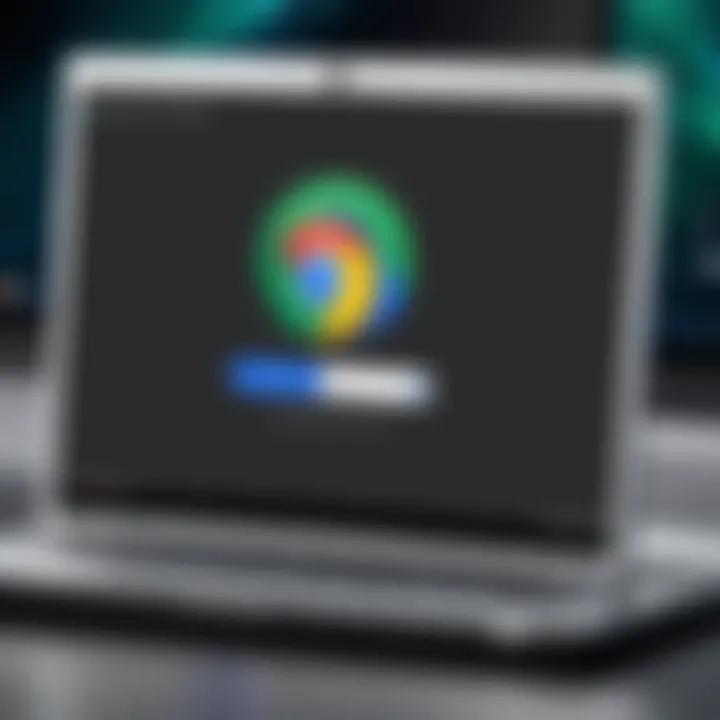In-Depth Look at the Chrome OS EXE Installer


Intro
In the landscape of operating systems, Chrome OS stands out for its unique blend of simplicity and power. At the core of navigating this environment is the Chrome OS EXE installer. This tool serves a crucial purpose, aiding users in understanding how to effectively utilize applications within the ecosystem. The importance of delving into the nitty-gritty of this installer cannot be overstated; a clear grasp of its functionalities enhances the user experience tremendously.
This article sheds light on the inner workings of the Chrome OS EXE installer, offering readers not just a surface-level overview but a thorough exploration of its myriad features, installation procedures, and compatibility issues.
Importance of Understanding the Installer
For tech-savvy individuals and enthusiasts, a comprehensive understanding of this tool is pivotal. With the advent of chromebooks and the increasing reliance on web-based applications, knowing how to effectively navigate the installation process can make life easier.
By unpacking the details surrounding the Chrome OS EXE installer, we aim to equip you with insights that will elevate your interaction with Chrome OS.
With each section of this article, you will unravel unique selling points, key specifications, and even the practical applications that this installer brings. Stick around as we dive deeper into the world of Chrome OS!
Foreword to Chrome OS
In today’s fast-paced digital landscape, operating systems form the backbone of our daily tech experiences. Chrome OS, developed by Google, has carved a niche for itself by focusing on simplicity and speed. Understanding Chrome OS is critical for anyone looking to navigate the evolving world of computing. This article serves as a comprehensive guide to the Chrome OS EXE installer, highlighting its unique functionalities and implications for users.
The relevance of Chrome OS can't be overstated. This operating system is often seen as an alternative to more traditional ones, such as Windows and macOS, especially in environments heavily reliant on cloud computing.
By delving into the inner workings of Chrome OS, readers will gain insights not only into its design and usability features but also into how it integrates with software and applications.
Definition and Overview
Chrome OS essentially functions as a lightweight operating system built primarily for web speed. It’s streamlined to support applications that rely on web-based interfaces. Unlike other operating systems, which often allow complex software setup, Chrome OS prioritises simplicity. It’s designed to boot up quickly, and the user interface is straightforward, ensuring even those less familiar with technology can navigate it with ease.
This operating system is typically found on Chromebooks, devices that are optimized for web applications, making them suitable for educational settings, professionals frequently transitioning between tasks, or anyone who values a straightforward computing experience. In essence, Chrome OS embodies the concept of efficiency in modern computing.
Core Features of Chrome OS
Chrome OS boasts a variety of features that cater to a diverse user base. Here are a few key attributes:
- Speed and Performance: One of the standout traits of Chrome OS is its remarkably fast boot-up time, often under ten seconds. This speed allows users to access the web and their applications without unnecessary delays.
- Security: With a special focus on security, Chrome OS employs automatic updates and sandboxing technology to isolate tasks and protect users from potential threats.
- Simplicity: The user interface is designed to minimize complexity, focusing predominantly on the essentials without the bells and whistles that often clutter other operating systems.
- Cloud Integration: By promoting the use of cloud services, Chrome OS makes data access and storage more convenient and scalable. Users can save their documents in the cloud and access them from any device with internet capabilities.
- Web-centric Applications: With an emphasis on online apps, Chrome OS inherently supports a plethora of productivity tools from Google Workspace and other cloud-based services.
This mixture of speed, security, and practical features makes Chrome OS a compelling choice for many users. Being informed about these aspects lays the groundwork for understanding the nuances that come with the Chrome OS EXE installer.
The Role of EXE Files
EXE files hold a crucial position in the world of computing, serving as executables that enable users to run applications and perform tasks on their systems. In the context of Chrome OS, these files embody a bridge between conventional software installation methods and the streamlined, app-centric approach that Chrome OS provides. Their significance extends beyond mere functionality; they represent an evolving solution to compatibility in an ever-changing tech landscape.
Understanding EXE Files
At their core, EXE files are program files that execute commands when opened. In simpler terms, when you double-click an EXE file, you are instructing your computer to perform specific tasks, which may include installing software, launching applications, or triggering scripts. This binary format is predominantly associated with Windows operating systems, but their relevance is spilling over into other systems, including Chrome OS, thanks to diverse development environments and software adaptability.
Within the realm of Chrome OS, an EXE file essentially acts like a key to unlock software operations that are not natively supported by the system. Understanding this relationship is paramount. As Chrome OS relies heavily on web applications, the use of EXE files is often seen as a workaround, allowing users to engage with traditional software that would otherwise be incompatible. This has made recognizing and utilizing EXE files essential for users who want to extend the capabilities of their devices.
Common Uses of EXE Installers
EXE installers are not only prevalent but also pivotal in various scenarios:
- Software Installation: The most prominent use of an EXE file is to install software. Users can download applications designed for Windows and attempt to use them on Chrome OS via compatibility layers or emulators.
- Game Installers: Many PC games come bundled as EXE files. While Chrome OS isn't typically considered a gaming platform, dedicated gamers often seek ways to access these titles through workarounds that involve EXE files.
- Utility Tools: Various tools designed to optimize system performance or provide specific functionalities, such as file compression or system recovery, often use EXE format for distribution.
- Legacy Applications: For businesses or tech enthusiasts utilizing software that hasn’t transitioned to a browser-based platform, EXE files offer a means to keep using their preferred applications.
"EXE files encapsulate a wealth of functional potential, often overlooked in the face of modern app-centric paradigms."
In essence, while Chrome OS promotes a more streamlined, cloud-oriented approach, understanding and utilizing EXE files can effectively expand user capabilities, enabling a broader engagement with software and applications that drive productivity. By grasping the role of EXE files, users can better navigate their tech environment, transforming potential obstacles into opportunities.


Chrome OS EXE Installer: An Overview
The significance of the Chrome OS EXE Installer within the broader landscape of technology cannot be overstated. As the demand for versatile systems increases, the focus on installation methods such as this plays a pivotal role in how users interact with software on their devices. The Chrome OS EXE Installer offers a means to operate Windows applications within the Chrome OS environment, which is not native to standard Chromebooks. This capability opens up new dimensions for users who wish to expand their system's potential while still enjoying the simplicity and efficiency that Chrome OS provides.
What is a Chrome OS EXE Installer?
In simplest terms, a Chrome OS EXE Installer serves as a bridge that enables users to install Windows executable files on a Chrome OS device. Although the OS primarily runs web-based applications, the EXE Installer provides a workaround for those looking to tap into mainstream software traditionally confined to Windows systems.
The installer functions by creating a virtual environment that can interpret and execute the Windows files, allowing a seamless transition from one platform to another. Users interested in leveraging their existing software can do so effortlessly, thus enhancing their productivity without the need for an entirely different operating system. This functionality is particularly valuable for professionals and enthusiasts relying on specific programs that are unavailable natively on Chrome OS.
Differences from Standard Installers
The distinctions between a Chrome OS EXE Installer and traditional software installers are quite pronounced. Here's a breakdown of some of the key differences:
- Environment Compatibility: Standard installers are tailored for specific operating systems and usually lack the flexibility to operate across different platforms. The Chrome OS EXE Installer, however, is designed to work specifically within a virtual environment, allowing Windows applications to run on a fundamentally different operating system.
- Ease of Use: While traditional software installations might require users to navigate through multiple prompts and complicated setups, Chrome OS's EXE Installer benefits from a more streamlined process. This can dramatically reduce the friction that users experience when setting up new software.
- Performance Variability: In standard environments, installations can execute with optimal performance, as they're directly coded for that operating system. Chrome OS's EXE Installer may result in variability in the performance of applications. The degree to which an application performs well can depend on many factors, including how resource-intensive the program is and the specifications of the Chromebooks themselves.
- Dependency Management: Traditional installers frequently manage dependencies during installation, installing required libraries and components automatically. Conversely, the EXE Installer may require users to manually address these dependencies, which could introduce complications if users lack the requisite technical knowledge.
Understanding these differences is crucial for users who wish to maximize the utility of their Chrome OS devices while successfully executing Windows programs. Awareness of the strengths and limitations of the Chrome OS EXE Installer is necessary for effective usage and to mitigate potential issues.
Installation Process of Chrome OS EXE
The installation process of Chrome OS EXE is not just a series of technical steps, but also a critical journey that sets the stage for an optimal user experience. Understanding this process can empower users, allowing them to navigate potential pitfalls and maximize the utility of their system. This aspect holds significant weight, especially given the growing reliance on cloud-based solutions and light-weight operating systems like Chrome OS.
Pre-Installation Requirements
To kick things off, there are some pre-installation requirements that must be satisfied to ensure a smooth installation process. Not meeting these can lead to frustration down the line. Here are some key elements to keep in mind:
- Adequate Storage Space: Make sure your device has enough available space. Too little room can cause the installation to fail or result in system instability post-installation. Aim for at least 4GB of free space.
- Compatible Hardware: Verify that your hardware meets Chrome OS’s minimum specifications. Not all devices will support an EXE installer flawlessly. Check your manufacturer’s guidelines for detailed compatibility information.
- Updated Firmware: An outdated BIOS or firmware version can be a roadblock. Consider updating these before continuing with the installation.
- Backup Data: Although the installation process is generally stable, it’s smart to keep backups of any critical data. Better safe than sorry.
Step-by-Step Installation Guide
Now that the pre-requisites are sorted, it’s time to get down to the nitty-gritty of the installation process. Here is a concise step-by-step guide to help you through this journey:
- Download the EXE Installer: Navigate to a trusted source to download the Chrome OS EXE installer. Avoid third-party websites to mitigate the risk of malware.
- Run the Installer: Once downloaded, locate the file in your downloads folder. Double-click the EXE file to launch the installer. You may need administrative permissions; don’t panic if prompted.
- Follow On-Screen Instructions: The installer will guide you through the necessary steps. Pay close attention to each prompt. Here, you might be asked to select a target directory for installation – choose wisely.
- Configuration Options: At this stage, you may be presented with configuration choices. These settings could include options like user accounts, permissions, and any additional software that might come bundled with the installation.
- Finish and Restart: After all selections are made, finalize the installation. Once it's completed, a prompt to restart your device should appear. This is crucial, as it allows the Chrome OS to load fresh settings and configurations.
- Initial Setup: Upon rebooting, follow the on-screen setup instructions, like connecting to your Wi-Fi. This will set the ball rolling for using your newly installed system.
"Patience is key in technology. Don’t rush through the installation; take the time needed to ensure everything is set up correctly."
By adhering to these steps, users can navigate the installation process with greater confidence. Allowing yourself the space to breathe and analyze will not only help in ensuring a successful installation but also foster a deeper understanding of Chrome OS and its functionalities.
Compatibility Considerations
The realm of technology is vast and ever-changing, and utilizing the Chrome OS EXE installer demands a keen understanding of compatibility aspects. This section explores why it is critical for tech enthusiasts to grasp these considerations before diving into installation or execution of software on their devices.
Understanding compatibility ensures that the processes go off without a hitch. It also reduces the risk of experiencing errors that could arise due to unsupported configurations. With the right combination of hardware and software, users can fully leverage the performance and capabilities of applications, minimizing frustration and maximizing productivity. In essence, it’s about getting the most bang for your buck when investing time and resources into new programs.
Supported Hardware Configurations
Getting ahead in tech often means keeping a pulse on which hardware can run specific applications. Chrome OS has a unique setup grappling with various components. Many users often overlook this when setting things up.
- Device Specifications: First off, the type of processor matters a ton. Most Chrome OS devices are powered by ARM or Intel chips. It’s essential that the EXE installer you plan to use aligns with these processors. If not, it’s akin to trying to fit a square peg in a round hole.
- RAM Requirements: Next up is RAM. Different applications have varying needs, and Chrome OS typically benefits from a minimum of 4GB RAM for smooth operation. If the hardware falls short, expect sluggishness or even failures to load applications altogether.
- Storage Space: Storage capacity can’t be forgotten. Having insufficient disk space can throw a wrench into the installation process, causing necessary files to go missing or installations to fail outright. Ideally, users should have extra headroom beyond the application’s requirements.
- Peripheral Support: Lastly, peripheral device compatibility can impact overall functionality. Companies often create software suited for certain configurations of printers or external drives that might not be supported by Chrome OS.
Understanding these aspects creates a smoother experience when installing applications through the Chrome OS EXE installer.
Software Requirements for Execution
While getting the hardware sorted is one thing, the software side of things is just as crucial. To put it bluntly, no one wants to deal with misbehaving software. Here’s what users should keep in mind:


- Operating System Version: Each iteration of Chrome OS comes with its quirks. Users need to ensure that their system is up to date to avoid incompatibility issues. Running on older versions can hinder the execution of newer software, resulting in errors or even crashes.
- Installation Permissions: Some installations require administrative rights. This means if you’re in a managed environment, restrictions might be in play. Knowing who has the keys to the system helps users to plan their installation accordingly.
- Dependencies: Often, an EXE installer doesn’t work in isolation. Dependencies, or associated software, might be needed for proper function. Users must take the time to do their homework on these complements to avoid headaches during execution.
- Internet Connectivity: With many applications leaning on cloud features, having a stable internet connection can be vital during installation and execution. Sometimes, missing this aspect can lead to incomplete installs, rendering the application useless.
Always double-check the documentation provided with the specific EXE installer for the most accurate requirements. A little effort upfront can save a whole lot of grief down the line.
When users navigate these complexities thoroughly, the experience smooths out considerably, aligning both hardware and software harmoniously with the Chrome OS systems.
Common Issues and Troubleshooting
Common issues with the Chrome OS EXE installer can be as frustrating as a flat tire on a road trip. It's important to address these problems effectively for a smooth experience. Technical issues can crop up during various stages of installation, causing not just annoyance but potentially halting productivity altogether. Having a good grip on troubleshooting allows users to navigate these hiccups confidently, saving time and resources in the long run. This section endeavors to bring clarity on typical installation errors and compatibility problems, proving vital in enhancing your overall understanding of the Chrome OS EXE installer.
Identifying Installation Errors
Pinpointing installation errors is a critical skill when working with the Chrome OS EXE installer. Often, the signs of a problem aren’t plastered all over the screen; sometimes, they lurk in the background like an unexpected rain cloud. Common clues include messages prompting users about corrupted files, failed installations, or unexpected app crashes. Addressing these can seem like trying to find a needle in a haystack, but with some diligence, it’s quite manageable.
Here's a breakdown of common symptoms to keep an eye on:
- Error Messages: Take note of any explicit error codes or warnings. They can be your roadmap to resolving the issue.
- Performance Lag: If the installation takes unusually long, it might be time to check system resources or disk space.
- Incomplete Installations: If the installer freezes partway through, that's a common red flag.
“Understanding these errors can save you a boatload of trouble in the future.”
Knowing what to look for will heavily reduce the time spent on solving installation hiccups.
Resolving Compatibility Problems
Even the most well-designed software can run into compatibility issues, especially in a landscape as varied as Chrome OS. An awareness of what systems and applications coexist smoothly with Chrome OS can stave off a slew of headaches.
When faced with compatibility issues, here are some steps you can consider:
- Check System Requirements: Ensure that your hardware meets the necessary specifications for the Chrome OS EXE installer. Mismatched specs can lead to insurmountable barriers.
- Review Update Status: Software often needs to play nice with the latest updates. Outdated systems may not support newer EXE files properly.
- Utilize Community Forums: Engaging with forums like Reddit can provide insights from users who’ve traversed similar roads. There’s an invaluable wealth of shared experiences.
- Consult Documentation: Vendor guidelines or support documentation can guide users toward compatibility resolutions.
Best Practices for Using Chrome OS EXE Installer
Using a Chrome OS EXE installer properly can save you from a heap of trouble down the line. There are several practices that, when followed, not only ensure a smooth installation process but also bolster software security and maintain system integrity. By understanding and implementing these methods, users can cultivate a more harmonious relationship with their technology.
Maintaining Software Security
One cannot overlook the importance of software security when embarking on the journey of using Chrome OS EXE installers. Cyber threats are as common as the rain, and one ill-fated click can lead to malware wreaking havoc on your system. Hence, maintaining software security should be at the forefront of your mind. Here are some pivotal points to consider:
- Verify Sources: Always download installers from reputable sources. Trust is hard to come by in the digital landscape, so it's vital to confirm the site and the file's authenticity.
- Use Antivirus Software: Keep your antivirus solutions up to date. A proactive approach to security can thwart potential threats before they get a foothold in your system.
- Enable Firewall Protections: Utilize the built-in Chrome OS firewall settings. They can act as a sentry against unwanted intrusions.
Implementing these security measures is like wearing a seatbelt while driving; it may not guarantee safety, but it significantly enhances your protection.
Regular Updates and Follow-Up Actions
Once the installation is complete, the work doesn't end there. Regular updates and follow-up actions are critical for maintaining the software's functionality and security. Here’s a rundown of why these practices matter:
- Stay Current: Software developers frequently roll out updates that fix bugs or patch security holes. Ignoring these updates is akin to leaving your front door wide open. Therefore, make it a habit to check for updates regularly—do it weekly or monthly, whatever suits your rhythm.
- Review Installed Programs: After installation, periodically reviewing what’s installed can help determine if any program is no longer needed or is causing issues. If an application isn’t meeting your expectations, don’t hesitate to uninstall it.
- Monitor Performance: Keep an eye on the machine's performance. If things start slowing down or behaving strangely, it might indicate deeper issues at play. Address them promptly.
Remember, keeping your system updated is like tending to a garden; neglecting it can lead to chaos and problems that could have been easily avoided. By following these best practices, users can secure and optimize their experience with Chrome OS EXE installers and confidently navigate the ever-changing world of technology.
Alternatives to Chrome OS EXE Installer
In an ever-evolving technological landscape, the idea of finding alternatives to any given tool becomes almost second nature. This is particularly true when it comes to installers. When considering Chrome OS and its associated EXE installer, understanding alternatives can provide flexibility and enhance functionality for users, making your tech journey just a bit smoother.
Exploring Other Installation Methods


While the Chrome OS EXE installer serves its purpose, it’s worth noting that there are various other installation methods that users should explore. These alternatives have their unique benefits, depending on the user's needs. Some of the other installation methods include:
- Web-based Installations: Many applications are available directly from the Chrome Web Store, allowing for easy and quick installation without needing an EXE file. This method encourages a streamlined experience, as everything runs seamlessly within the Google ecosystem.
- Linux Applications: Chrome OS supports Linux-based applications. Users can enable Linux (Beta) and install applications using or other package managers. This opens up a whole new world of software possibilities that aren't available through the EXE installer.
- Android Apps: The capability to run Android applications on Chrome OS provides another layer of versatility. Apps can be downloaded directly from the Google Play Store, offering a wide selection of software that operates effectively on Chrome OS devices.
Such methods not only diversify the software options available but can also enhance compatibility, as they often come directly optimized for Chrome OS.
Comparative Analysis of Installer Types
Understanding different types of installers paints a clearer picture of your choices. Each installation method has its pros and cons. Here’s a brief breakdown:
- EXE Installers: Typically preferred by users who are familiar with Windows environments. However, their limited support for Chrome OS could pose a challenge.
- Web-based Installers: These allow for quick installation through browsers and generally ensure the latest versions of software, reducing worries about outdated programs.
- Package Managers (like APT): This installation type is particularly beneficial for advanced users who want fine control over the application environment. Although it may present a steeper learning curve, it’s a powerful method.
When looking at the bigger picture, the choice between these installers often hinges on individual needs and tech savviness.
In summary, by diving into these alternatives and understanding the comparative analysis of installer types, users can make informed decisions that not only meet their current requirements but also allow for future flexibility. Remember, the world of technology is vast, and opting for the right tool can make all the difference in your experience.
"Exploration of alternatives ensures you’re not just following the crowd but enhancing your tech journey with informed choices."
By being open to different methods, users stand to gain considerably. It’s all about making the technology work for you, so don’t shy away from exploring options outside the norm.
Future Directions for Chrome OS Installers
The exploration of Chrome OS EXE installers doesn’t merely end at understanding their functions and limitations. We stand at a crossroads where technology seamlessly blends with our daily needs, pushing boundaries to offer more efficient solutions. Future developments in this arena will significantly influence user experiences and software proliferation on Chrome OS platforms. To appreciate these directions, it's key to assess how evolving trends and user demands play into the mixing pot of innovation.
Trends in Installer Development
There’s a noticeable shift in how developers approach installation processes. The installation has traditionally been a tedious chore, often requiring a manual and sometimes convoluted procedure. However, several trends are emerging that tilt the industry toward streamlined and user-friendly methods:
- Containerization: This method, which isolates an application's dependencies from the system, allows multiple applications to coexist without conflict. Expect more Chrome OS installers to embrace this model, enhancing stability and overall user satisfaction.
- Cloud-based Installers: With increased reliance on the cloud, installers that leverage remote storage and execution are gaining traction. This not only reduces the local hardware burden but also simplifies the update mechanisms, ensuring users receive the latest features without lifting a finger.
- Cross-Platform Compatibility: Future Chrome OS EXE installers could expand their adaptability to cater to a multitude of devices. This would empower users who operate multiple systems simultaneously, eliminating redundancy and fostering a more integrated user experience.
These trends indicate a marked shift toward convenience and efficiency. As the ecosystem evolves, so too does the importance of these installers in providing seamless access to applications and services.
Potential Enhancements in User Experience
The user experience (UX) is the ultimate barometer by which the success of software solutions is measured. Enhancements in this area can mean the difference between adoption and abandonment. Here are a few potential enhancements we might see in the near future regarding Chrome OS installers:
- Intuitive Interfaces: A significant emphasis on design simplicity could lead to installers that better guide users through the process. This could include interactive wizards or even AI-based assistance to personalize the installation journey.
- Error Handling: Improved error detection and recovery mechanisms can facilitate smoother installations. A more responsive system that can address issues in real-time would minimize user frustration and bolster confidence in installing new software.
- Customization Options: As users grow more sophisticated, their needs diversify. Offering customizable installation settings can empower users to tailor installations according to their specific requirements or preferences.
Such enhancements not only cater to the current users but also pave the way for attracting newcomers to the Chrome OS landscape. Investing in a robust user experience ensures that technological progress resonates with people's needs and lifestyles.
"User experience is not just what it looks like and feels like. User experience is how it works." – Steve Jobs
Understanding the future directions for Chrome OS installers isn't just a speculative exercise; it's pivotal for creators and users alike who wish to remain in sync with the technological advancements on the horizon. With ongoing trends and potential enhancements, we can anticipate a more user-centric approach that underscores the importance of adaptability and reliability in software installation processes.
Closure and Final Thoughts
Understanding the Chrome OS EXE installer is like peeling back the layers of an onion. Each layer offers new insights that build on what came before, ultimately leading to a well-rounded grasp of how it functions and its broader implications. The importance of this topic is multi-faceted, particularly when we consider how integral installers are to the software ecosystem. They act as the bridge between something as abstract as code and the tangible applications we use daily. With the growing adoption of Chrome OS among users, mastering the nuances of its EXE installer becomes increasingly vital.
Summarizing Key Points
In this exploration, we’ve covered various critical aspects that highlight the relevance and utility of the Chrome OS EXE installer:
- Definition and roles of EXE files: Understanding what these files are and their typical applications sets the groundwork for deeper comprehension.
- Installation Process: The detailed steps help demystify what can often feel like a daunting task, making it approachable for users at any level of technical proficiency.
- Compatibility Considerations: Knowing the hardware and software requirements enables a smoother installation and operational experience, preventing user frustration.
- Common Issues and Troubleshooting: A proactive approach with clear identification of potential problems empowers users to tackle challenges head-on rather than feeling stifled by them.
- Best Practices and Alternatives: Establishing safe practices can greatly enhance software security and lead to informed decision-making regarding installation methods.
Encouraging Informed Use of Technology
As the tech world continues to evolve at a breakneck speed, being an informed user becomes paramount. The Chrome OS EXE installer represents not just a tool but a gateway to an ecosystem full of possibilities. Embracing technology wisely means recognizing the big picture while also grasping the finer details.
"Knowledge is power only if you use it wisely."
Informing oneself about the capabilities, limitations, and processes surrounding technology, like the Chrome OS EXE installer, leads to greater empowerment. Users can leverage this knowledge to optimize their interactions, safeguard their systems, and make astute choices about software installation. The balance of using technology with an informed touch ensures that individuals remain not just consumers but confident navigators in an increasingly complex digital landscape.







